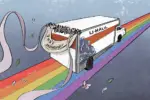The NHL is trying to keep up with the times. As identity-based issues rise to the top of our newsfeeds, the demand for increased diversity and inclusivity has skyrocketed. Although we’ve barely cracked the surface, mainstream media and even corporations have been taking noticeable measures to boost inclusivity. Companies and organizations have shown a greater interest in satisfying the demand for equality in areas such as race, religion, nationality, gender and sexual orientation, to name a few.
Professional sports have jumped on the bandwagon too — the NBA is working toward gender equality, while the MLB has taken a stand with various LGBTQ-friendly events during Pride month. Interestingly, one of biggest leaps toward inclusivity has come from the National Hockey League. In terms of race, gender and sexuality, the NHL has historically been one of the least diverse professional sports in North America, but this year, they are working to change that.
The Issues
One of the biggest barriers to diversity in hockey is its accessibility. When kids take an interest in sports, most parents cross their fingers in hopes of something inexpensive, like volleyball or baseball, and many parents, in turn, cringe when their child decides that they want to play ice hockey. Between the head-to-toe equipment (most of which needs to be replaced as kids grow), rink time and skating lessons, it’s no wonder that hockey is one of the most expensive sports to get into.
This creates a socioeconomic barrier; many kids that want to can’t afford to play. This goes hand-in-hand with issues of race — since people of color disproportionately experience poverty — and the result is that hockey is, on the whole, a blindingly white sport, a problem that is especially reflected on the professional level. In the 2018-19 season, the NHL signed 33 players of color, which is roughly 5% of the league — meaning that white players make up the other 95% of the roster.
Though pro hockey has come a long way since 1958, when Willie O’Ree became the first black player to enter the league, 5% is still disappointingly small. This level of homogeneity can be difficult to break through because, socioeconomic barriers aside, players of color might feel unwelcome in a predominantly white sport, especially since the league still struggles with issues of racism.
Another worrisome gap in the sport is gender based. In women’s professional hockey, there are two leagues: The National Women’s Hockey League and the Canadian Women’s Hockey League. The NWHL has only five teams, in contrast to the NHL’s 31; meanwhile, the CWHL announced in March that it will be shutting down completely.
Within the NHL, the only full-time female coach in the league was hired just a few years ago, in 2016. While there’s also been a push to allow female players into the NHL, the idea has not gained much traction, so there remains a huge disparity when it comes to gender in pro hockey.
Yet another problem that plagues the league is the issue of its players’ sexual orientations — there are no openly gay players in NHL history. Statistically, it’s likely that there have been gay players who have come and gone in the league, but Canucks goalie Anders Nilsson seems to think that the NHL truly is disproportionately straight. After all, in recent years, gay players have come out in almost every professional sport, except for hockey.
“I think when people say there are three to four gay players on each [NHL] team, I say no, absolutely not. They quit when they were younger,” he said in an interview with Swedish newspaper Aftonbladet. “If I was gay, I would have quit playing hockey in my teens.” Nilsson expressed resentment toward homophobia in the locker room, and believes that stigma from the public keeps gay players from going pro.
The Solutions
To combat these issues, the NHL is growing its inclusion program, “Hockey is for Everyone,” which has been slowly tackling issues of race, gender and sexuality-based inequities within the league since 1998. The program has expanded its reach, and it’s now in effect year-round, rather than just during, say, Pride Month or Black History Month.
Its main goal is to increase the league’s racial diversity, encourage young women who play the game and advocate for the LGBTQ community. They have instilled a Declaration of Principles, which reads like a manifesto of sorts, that states that hockey should be a safe environment for all players “regardless of race, color, religion, national origin, gender, age, disability, sexual orientation and socio-economic status. Simply put, hockey is for everyone.”
In 2016, the NHL launched their “Learn to Play” program, which encourages kids of all identities to get involved in the game. They provide free ice time and specifically target low-income communities.
In March of this year, the National Hockey League Players’ Association established the Female Hockey Advisory Committee, which is “dedicated to accelerating the growth of female hockey.” This was done during the first-ever Gender Equality Month campaign, and the advisory committee is comprised of 11 women with decades of experience both playing and coaching pro hockey. The committee plans to consult with the league on how to make hockey more accessible for young women and girls.
Perhaps most prominently, the NHL has begun to develop a strong presence in the LGBTQ community. Players have donned rainbow tape on their sticks and been active in Pride festivities in an adamant show of the league-wide support for the community. Interestingly, though, the NHL’s most-advertised form of inclusivity has had the least development. Despite the league’s commitment to inclusion, not a single player has come out.
Pride Month might be over for 2019, but the message of #HockeyIsForEveryone will always continue. pic.twitter.com/q56lYdZXtq
— NHL (@NHL) July 3, 2019
Could it be that players are still afraid to exist openly in the pro hockey environment? Or is Anders Nilsson right about the actual lack of queer players in the league?
Still, the NHL has come a long way in its effort to promote diversity and inclusion throughout the league, and there’s something to be said about their commitment to year-round efforts; it gives the impression that this isn’t an attempt to pander to a fanbase. Rather, the NHL seems genuinely committed to diversifying itself and improving access to hockey, simply for the love of the game.
















